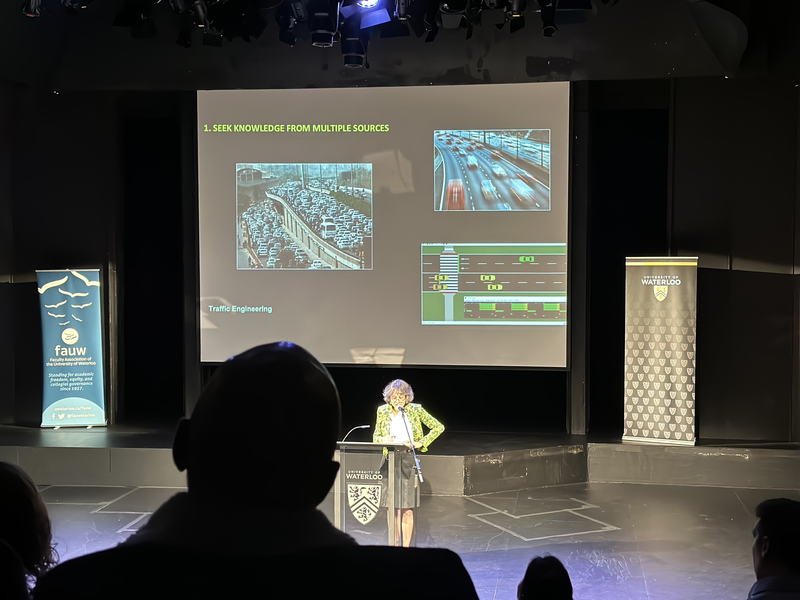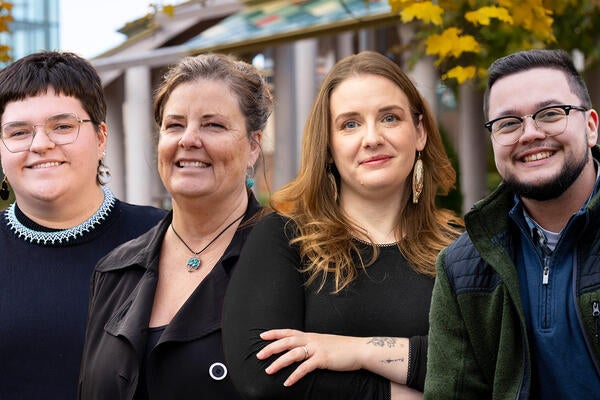
2023 Hagey Lecture encourages interdisciplinary approaches to being
Waterloo welcomed distinguished professor Nalini Nadkarni to share interdisciplinary perspectives on the nature of disturbance and recovery

Waterloo welcomed distinguished professor Nalini Nadkarni to share interdisciplinary perspectives on the nature of disturbance and recovery
By Darren McAlmont University RelationsFor more than 50 years, the University of Waterloo has hosted an insightful and thought-provoking public lecture series: The Hagey Lectures. This premier event has featured a wide range of celebrated scholars, artists and change makers.
Aimed at bringing outstanding individuals who have distinguished themselves internationally in some area of scholarly or creative endeavour, Waterloo was pleased to welcomed Dr. Nalini Nadkarni, professor of biology at the University of Utah, for the 2023 Hagey Lecture titled “Tapestry thinking: Interdisciplinary perspectives on the nature of disturbance and recovery.”
The event kicked off with a word from Jim Rush, vice-president, academic and provost.
“Over the years, our community has been inspired by the depth and breadth of knowledge that has been shared by our distinguished speakers. Through their talks, we are reminded that with a clear vision, strategic approach, and enthusiastic determination, we can make what seems impossible, reality.”
 When Nadkarni took the stage, her first order of business was to explain what tapestry thinking is and its importance to solving and responding to societal challenges.
When Nadkarni took the stage, her first order of business was to explain what tapestry thinking is and its importance to solving and responding to societal challenges.
In our western system, we have developed institutions that have broken down our world into different specialized threads: science, language, history, art, etc. Each has generated its own vocabulary and spheres of exchange, like conferences just for scientists, for example. While there is strength and depth in learning our respective fields very well, the consequence is that we now lack the capacity for ready exchange.
Just about every question we want to answer, from the simplest to most complex, requires input from multiple disciplines. Believe it or not, even changing a flat tire requires input from different disciplines. That’s why we need to adapt ways to both think and act in ways that allow exchange, interweaving and understanding.
“Tapestry thinking is bringing together seemingly odd bedfellows — people of diverse knowledge and ways of doing to interact in ways that contribute to building something like a real tapestry — that is connected, complex, strong, useful and beautiful,” Nadkarni said.
Key among the themes in Nadkarni’s lecture was the notion of “disturbance and recovery,” the former of which she asserted is neither negative nor rare. In fact, she stressed that in many cases, disturbance is required for progress. Recovery, on the other hand, is extremely rare. “Disturbance creates impacts that stops the norm, clears the deck and allows new ways of doing, thinking and being,” she said.
“But we never really return to the original state. Instead, we move to a ‘3rd state’ — neither the disturbed state nor the original state, but what is a new state that can be judged in different ways. But often — something we can welcome, despite its difference from where we were.”
Drawing on over 40 years of experience in academic science research, Nadkarni shared the beauty of the outcomes from her willingness to learn from and to collaborate with faculty from other disciplines. It all started after not receiving the funding support she needed to explore a specific forest ecology question. Undeterred by the disappointment, she started thinking of interdisciplinary ways to flesh out the answer.

That’s when, in 2014, Nadkarni recruited faculty from various fields at the University of Utah that deal with disturbance and recovery. They met for a full year, initially discussing the single thread of each discipline and how they could be used to better understand forest ecology. Later, they began weaving their collective ideas together and developed some emerging concepts about disturbance and recovery that yielded theories they were able to exchange with others to help provide insights for their respective fields.
Nadkarni noted that this kind of interdisciplinary work is not always favourably viewed by the academy but insisted that while pure science and modern languages might seem distant from each other, the perspectives from each discipline allow us to have a richer understanding of the world around us and the spaces we occupy. “That’s why it is time to start changing the academic system to make it easier for interdisciplinary work to thrive and be respected,” she emphasized.
Closing out her lecture, Nadkarni made it clear that interdisciplinary work extends beyond academic settings. “This is something that all of us can do, we can all share what we know, what we are curious about. No matter the sector or way of knowing, we have to weave together, collectively, this tapestry of understanding and care.”

Read more
Here are the people and events behind some of this year’s most compelling Waterloo stories

Read more
It Started in Waterloo: An Astronaut's Journey into the Universe of Innovation, narrated by Chris Hadfield, highlights the University of Waterloo’s role in igniting innovation within the region and beyond.

Read more
Researchers awarded funding to investigate ecology, climate change, repatriation, health and well-being through cultural and historical lens
The University of Waterloo acknowledges that much of our work takes place on the traditional territory of the Neutral, Anishinaabeg, and Haudenosaunee peoples. Our main campus is situated on the Haldimand Tract, the land granted to the Six Nations that includes six miles on each side of the Grand River. Our active work toward reconciliation takes place across our campuses through research, learning, teaching, and community building, and is co-ordinated within the Office of Indigenous Relations.